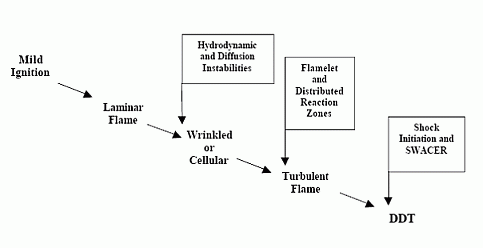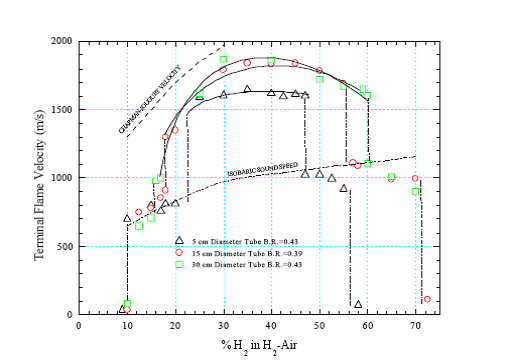
|
BRHS /
Accelerated flame propagationC. Chan, P. Thibault cited by OECD-SOAR „Flame Acceleration and DDT“ (Breitung, 2000) A freely expanding flame is intrinsically unstable. It has been demonstrated, both in laboratory-scale experiments (Wagner, 1982, Moen, 1982, Lee, 1985, Chan, 1981) and large-scale experiments (Hjertager, 1983, Moen, 1982, Van Wingerden, 1986, Cummings, 1987), that obstacles located along the path of an ex-panding flame can cause rapid flame acceleration. Qualitatively, the mechanism for this flame accel-eration is well understood. Thermal expansion of the hot combustion products produces movement in the unburned gas. If obstacles are present, turbulence can be generated in the combustion-induced flow. Turbulence increases the local burning rate by increasing both the flame surface area and the local mass and energy transport. An overall higher burning rate, in turn, produces a higher flow veloc-ity in the unburned gas. This feedback loop results in a continuous acceleration of the propagating flame. Under appropriate conditions, this can lead to transition to detonation.  Figure 1. Regimes of flame propagation from laminar flame to deflagration-to-detonation-transition (DDT). Turbulence induced by obstacles in the displacement flow does not always enhance the burning rate. Depending on the mixture sensitivity, high-intensity turbulence can lower the overall burning rate by excessive flame stretching and by rapid mixing of the burned products and the cold unburned mixture. If the temperature of the reaction zone is lowered to a level that can no longer sustain continuous propagation of the flame, a flame can be extinguished locally. The quenching by turbulence becomes more significant as the velocity of the unburned gas increases. For some insensitive mixtures, this can set a limit to the positive feedback mechanism and, in some cases, lead to the total extinction of the flame. Hence, both the rate of flame acceleration and the eventual outcome (maximum flame speed attained) depend on the competing effects of turbulence on combustion. Depending on the fuel concentration and the flow geometry, flame acceleration may be expected to progress through a series of regimes as depicted in Figure 1. For the case of mild ignition, the first phase involves a laminar flame that propagates at a ve-locity determined by the laminar burning velocity and the density ratio across the flame front. This phase of the flame propagation is very well understood and data is available for a wide range of hydrogen-air mixtures. The laminar flame propagation regime is relatively short-lived and is soon replaced by a "wrinkled" flame regime. For most accidental explosions, this regime can persist over relatively large flame propagation distances. For this reason, it is therefore far more important than the initial laminar regime. Due to the increase in flame area, the burning rate, and hence the flame propagation velocity for the wrinkled flame, can be sev-eral times higher than for the laminar flame.  Figure 2. Maximum flame speeds for H2-air mixtures in tubes of different sizes. Due to turbulence generated by obstacles or boundary layers, the wrinkled flame eventually transforms into a turbulent flame brush. This results in further flame acceleration due to the increase in surface area of the laminar flamelets inside the flame brush. For sufficiently high levels of turbulence, the flamelet structure may be destroyed and then replaced by a distrib-uted reaction zone structure. The flame acceleration process can eventually lead to DDT. For configurations involving re-peated obstacles, the turbulent flame propagation regime is self-accelerating due to the feed-back mechanism between the flame velocity and the level of turbulence ahead of the flame front. The final flame velocity produced by the turbulent flame acceleration process depends on a variety of parameters including the mixture composition, the dimensions of the enclo-sure, and the size, shape and distribution of the obstacles. Figure 2 shows the maximum flame speed achievable in tubes of various diameters. Various turbulent flame and detonation propagation regimes have been identified for hydrogen-air mixtures in obstacle-filled tubes. These regimes include: - A quenching regime where the flame fails to propagate;
- A subsonic regime where the flame is travelling at a speed that is slower than the sound speed of the combustion products;
- A choked regime where the flame speed is comparable to the sound speed of the combus-tion products;
- A quasi-detonation regime with a velocity between the sonic and Chapman-Jouguet (C-J) velocity;
- A C-J detonation regime where the propagation velocity is equal to the CJ detonation ve-locity.
It should be noted that the above regimes are geometry-dependent for a given mixture. Con-sequently, the concentration range for each regime in Figure 2 may differ for circular tubes and rectangular channels. Breitung W., Eder A., Chan C.K. e.a. SOAR on flame acceleration and DDT in nuclear safety, O-ECD/NEA/CSNI/R (2000) 7, 2000. << Non-uniform mixtures deflagrations | Content | Pressure waves from deflagrations: dependence on flame velocity and acceleration >> |